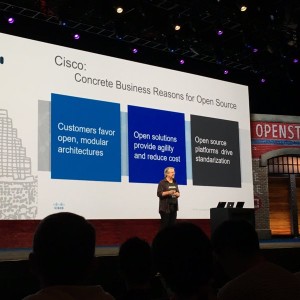WIRED said that ‘Open Source went nuclear‘ in 2015. Join the xiRADIO lunch-time podcast on May 18, to explore the forces disrupting the software industry.
Today, more than 3 out of 4 companies run on open source software, a pace that keeps increasing (it doubled since 2010). Why so much interest? There exist a wide variety of reasons, we can resume in three big points for now. (Note to the purists: to further simplify, I’m putting Free Software and Open Source in the same bag.)
#1 – Open Source is good for customers.
 Cisco @lewtucker arguing for Open Source at the recent OpenStack Summit
Cisco @lewtucker arguing for Open Source at the recent OpenStack Summit
(Austin TX, April 26, 2016)
It is no surprise that Google, Facebook and other IT giants have built most of their entire business on Free/Libre Open Source Software. According to Sylvain Carle, former Twitter employee and FLOSS advocate, Twitter runs on about 95% of Open Source software. It’s a great way to bootstrap a company, and to scale fast. Lew Tucker, Cisco Cloud VP/CTO, explained why Open Source makes sense to his business partners at the recent OpenStack Summit. Open Source is less expensive (e.g. no vendor lock-in, no per-user or per-CPU fee that would not allow scaling exponentially), more productive (e.g. code reuse, sustainability, agility), and it levels the playing field for everyone to collaborate and to compete, thanks to industry standards.
#2 – Open Source is good for IT Services companies.
 Wipro’s recorded presentation at the recent OpenStack Summit (April 2016)
Wipro’s recorded presentation at the recent OpenStack Summit (April 2016)
Open Source builds on a deep tradition of Savoir-faire (Know-How) considered as best practice in the software development industry. That’s why companies like PayPal adopted Open Source practices without necessarily adopting Open Source (strictly speaking Open Source refers to a type of software licensing). They call this practice InnerSource: “a great tool to help break down silos, encourage internal collaboration, accelerate new engineer on-boarding (…)”. One step ahead in sophistication, Wipro leveraged Open Source to improve employee engagement and expertise. The Open Source way encourages developers to collaborate and to learn new skills fast, which is life and blood for service companies selling their time and expertise.
#3 – Open Source is the new de facto outsourcing model.
 A short history of Kubernetes
A short history of Kubernetes
Most software is so complex that it can’t be developed by a single individual. More recently, large companies also have started to question whether they should carry the burden of developing everything on their own. When Google open sourced Kubernetes, derived from Borg -an internal tool that made scalable updates possible for services like Gmail, most major industry players offered to partner almost immediately. Although it may sound crazy that Google wanted to share their secret sauce, in fact it wasn’t really. Google did not vanish. As a result, the entire industry started to work together on improving how Google deploys software, and how everyone else is. Google ended up outsourcing part of their R&D for free, while scoring big points on technical leadership and vision. Today’s new normal is that two-thirds of companies find a benefit in contributing to Open Source.
In conclusion, did Open Source win?
Lao Tzu explains the principle of Self Realization in the Tao as 无为 (Wú Wéi), or the art of non-doing. If we look back a few years ago, we can wonder what happened to the dualistic view between Proprietary and Open Source software. What happened to all the hate between one side calling the other a ‘cancer’, and the other complaining about an imposed software ‘tax’ on computing? There is no such thing as winning or losing in achieving the harmony of Tao.
If today’s world seems much wiser, it is also more pragmatic. Software is often times governed by a blend of Open Source and other licenses. For example, Microsoft has nearly become an Open Source company close to open source Windows, and contributing to GitHub “with love”.
Whenever peace and love rule, carefreeness should not turn in carelessness. We should worry that a great majority of code on GitHub lacks a license (which means the author was clueless or did not care), and some thinkers like Nadia Eghbal already speak about a post-Open Source world. In fact, like Monsieur Jourdain, in Moliere’s play, suddenly realizing he had been speaking prose all his life, we see many young developers using Open Source tools without even knowing what Open Source is.
For end-users, it may well be that nothing has changed. They have to continue relying on intelligent and enlightened software developers and companies, hoping they won’t have to trade their Freedom and Privacy for good design and convenience.
Update May 19: The podcast is available on Vimeo.





 A short history of Kubernetes
A short history of Kubernetes



